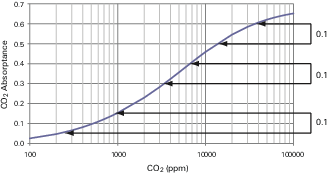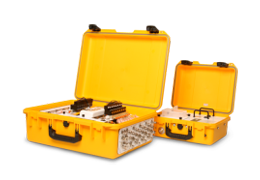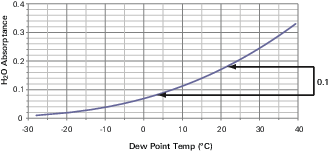If you find that after zeroing then spanning at one concentration, the instrument is not within specifications at a different concentration, a secondary span may be in order. The optical bench in the LI-8100A uses a span value that is a linear function of absorptance, with two parameters; a slope and an offset. The normal span function adjusts the offset and leaves the slope alone. Setting the secondary span (Span 2 tab) adjusts the slope, and then adjusts the offset value for the new slope value. The slope and offset values can be viewed under the Manual tab in the Calibration window. Span offset values (CO2 Span and H2O Span) are typically 1.0 ± 0.1.
Span slope values (CO2 Span 2 and H2O Span 2) are typically 0 ± 0.1. When they are exactly zero, then slope is a constant, and not a function of absorptance.
The CO2 span slope value is first determined at the factory by setting the span at 200 ppm, and doing a secondary span close to 20,000 ppm. This value should remain valid for some time. Things that are likely to make it change include changing the source and/or detector, a dirty optical cell, and possibly when taking the optical bench apart for cleaning.
Considerations for performing a secondary span
- Zero the instrument first, then do a normal span.
- The span and secondary span concentrations should be as far apart as possible, and they should bracket the concentration range of interest to you (e.g. 200 and 20,000, or 300 and 1500, etc.).
- “Far apart” means in absorptance, not concentration. We recommend absorptance differences of at least 0.1 when choosing concentrations for setting span and secondary span (Figure 7‑4).

For CO2, the difference in absorptance between 200 and 1000 ppm is typically about 0.1. There is also a 0.1 absorptance difference between 3500 and 7000 ppm, and between 15,000 and 40,000 ppm. For H2O, it is a little harder to get a 0.1 absorptance difference. If you want to do a secondary span at room temperature, the two span values would need to be 5 °C or less, and 22 °C, for example, as shown below.
You can perform multiple secondary spans after a normal span. For example, span at 200, then do a secondary span at 3000 ppm. Then, if you don’t like the result, you can do another secondary span at 2000 ppm. As long as the secondary span is well away (in absorptance) from the previous normal span, it is OK to do as many consecutive secondary spans at various concentrations as you’d like.
Setting the second span
![]()
In the PC Software:
Configure the Data view to show CO2 (µmol/mol) and H2O (mmol/mol).
Go to Utilities > Calibration and go to the Span 2 tab.
When the H2O or CO2 concentration is stable, click Span 2 H2O or Span 2 CO2.
![]()
In the App:
Go to Utilities > Calibration, then tap Perform: Zero.
Under the H2O tab, tap Send Command when the H2O reading is stable.
Under the CO2 tab, tap Send Command when the CO2 reading is stable.
Remember that it may take 15 to 20 minutes for the water vapor to stabilize.

